您的购物车目前是空的!
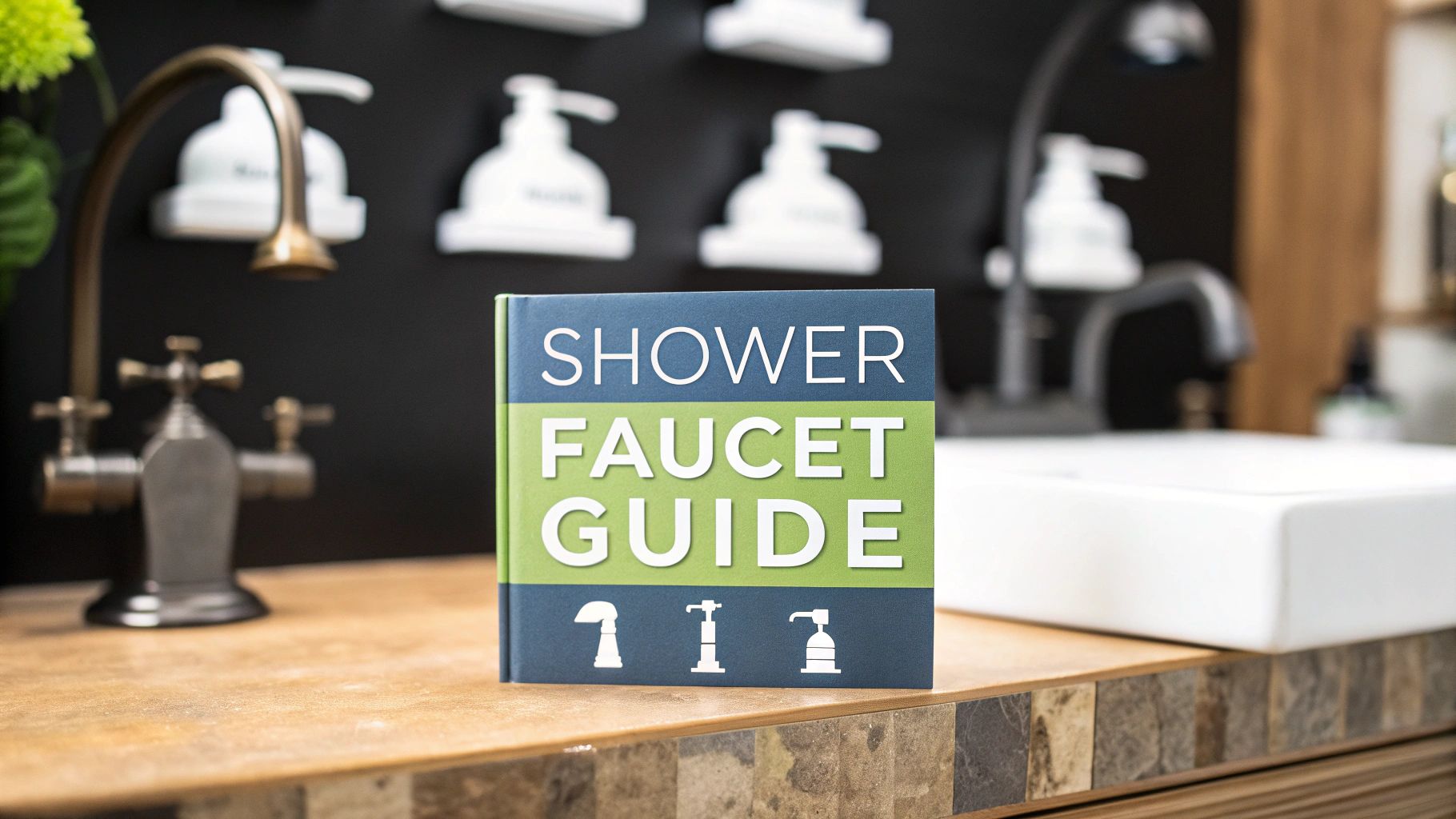
A Guide to the Different Types of Shower Faucet
Picking out a new shower faucet can feel like a bigger deal than it should. But really, it all boils down to a few key differences in how they work. This guide will walk you through the different types of shower faucet, breaking down how each one controls the water and what that means for your daily shower.
We'll start with the basics, comparing simple manual controls to the more advanced valve systems that put safety and comfort first.
Your Guide to Choosing the Right Shower Faucet
Think of a basic manual faucet like a classic stick-shift car—you're in complete control, but it takes a little finesse to get it just right. The more advanced faucets? They’re like driving an automatic; they do all the complicated work behind the scenes so you don't have to. We'll get into the nuts and bolts of single-handle, double-handle, pressure-balancing, and thermostatic faucets.
Once you have this foundational knowledge, you'll be able to confidently navigate your options, whether you're planning a complete bathroom tear-out or just a simple weekend upgrade. This will set the stage for a closer look at specific styles, from those luxurious rain shower faucet models to practical bath shower set combos, helping you find the perfect balance between style, budget, and everyday function.
Understanding the Core Faucet Technologies
It's no surprise that the shower faucet market is booming. According to industry analysis, the global market is expected to grow significantly, driven by a demand for fixtures that offer both aesthetic appeal and enhanced functionality. This isn't just about replacing old hardware; it's a global shift toward fixtures that look great and perform even better.
This infographic gives a great visual breakdown of the key differences between the main types of faucets you'll encounter.
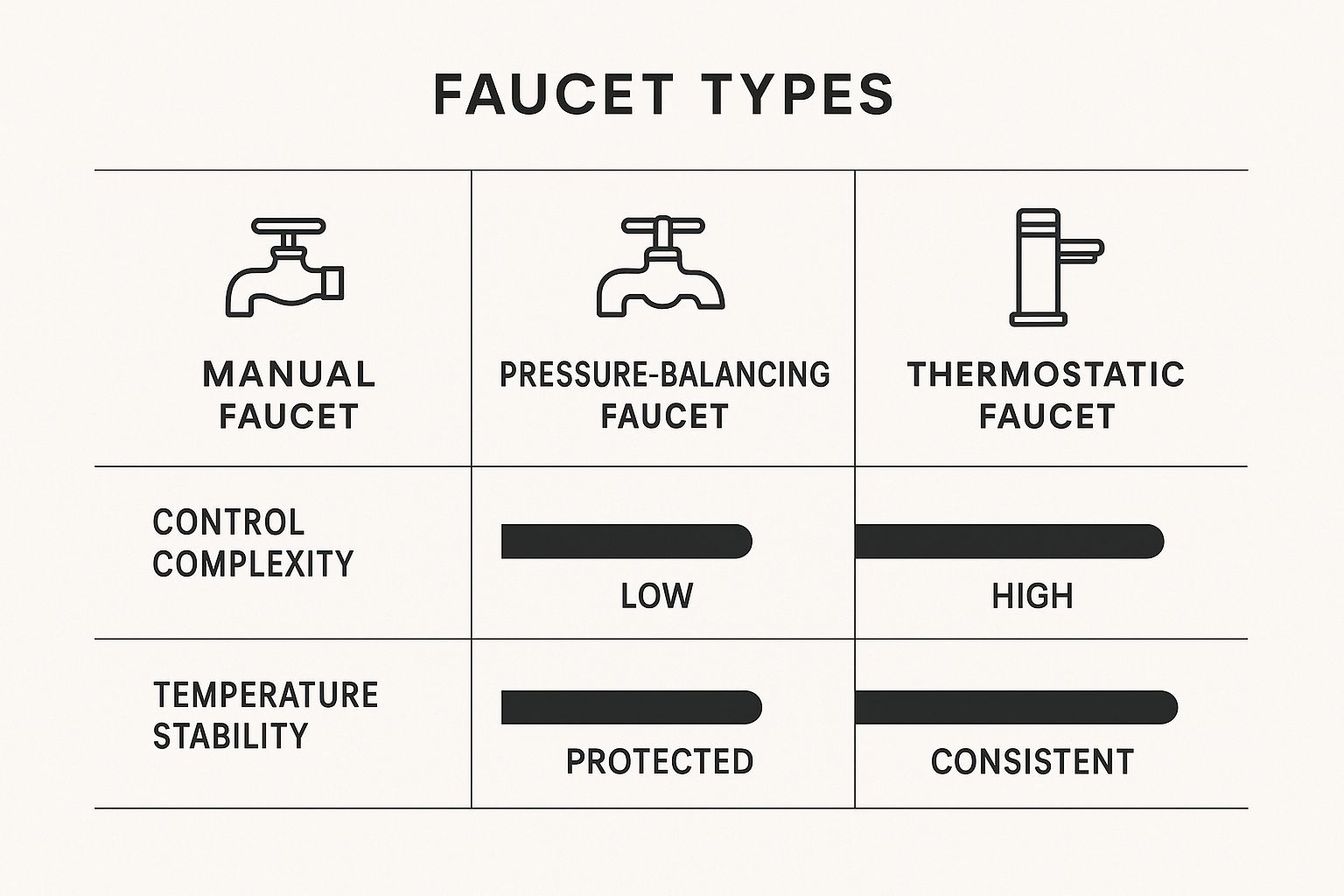
As you can see, it's a trade-off. Thermostatic faucets give you rock-solid temperature stability but have more complex controls. On the other end, manual faucets are dead simple to use, but you might get a surprise jolt of cold water now and then.
To give you a clearer picture, here’s a quick rundown of the main faucet types and what they’re all about.
Shower Faucet Types at a Glance
| Faucet Type | How It Works | Best For | Key Benefit |
|---|---|---|---|
| Manual | A single lever or two knobs directly mix hot and cold water. | Basic setups, budget-conscious projects, or guest baths. | Simplicity and low cost. |
| Pressure-Balancing | A single handle controls both volume and temperature; an internal valve balances pressure to prevent scalding. | Most homes, especially those with kids or fluctuating water pressure. | Safety from sudden temperature spikes. |
| Thermostatic | Separate controls for water volume and temperature; maintains a precise temperature. | Luxury showers, multi-outlet systems, and homes with elderly individuals. | Unmatched temperature precision and consistency. |
This table should help you quickly see which technology aligns best with what you need for your own bathroom project.
Making an Informed Decision
Getting a handle on these basics is the first real step toward a successful bathroom project. Each faucet type offers a completely different experience in the shower, from the no-fuss operation of a single-handle model to the precise, set-it-and-forget-it temperature control you get with a thermostatic system from a trusted brand like CRANACH.
Your choice of faucet impacts not just the look of your shower, but also its safety and daily comfort. A faucet that prevents sudden temperature spikes is more than a luxury—it's a key safety feature for households with children or elderly family members.
For a wider view on how all your bathroom pieces can work together, it's worth checking out this expert advice on choosing the right bathroom fixtures. And remember, the principles of balancing form and function don't stop at the shower. You can find more tips in our guide on how to choose a bathroom faucet for your sink to create a look that feels cohesive and thoughtfully designed.
https://cranachhome.com/articles-buyingguide/how-to-choose-a-bathroom-faucet/
Getting to Grips with Manual Shower Faucets
When you start digging into the different types of shower faucets, the first ones you’ll always run into are the manual kind. These are the straightforward, no-fuss workhorses of the bathroom. They rely on you—not any fancy balancing tech—to mix the hot and cold water. Think of them as the classic foundation that all the more complex systems are built on.
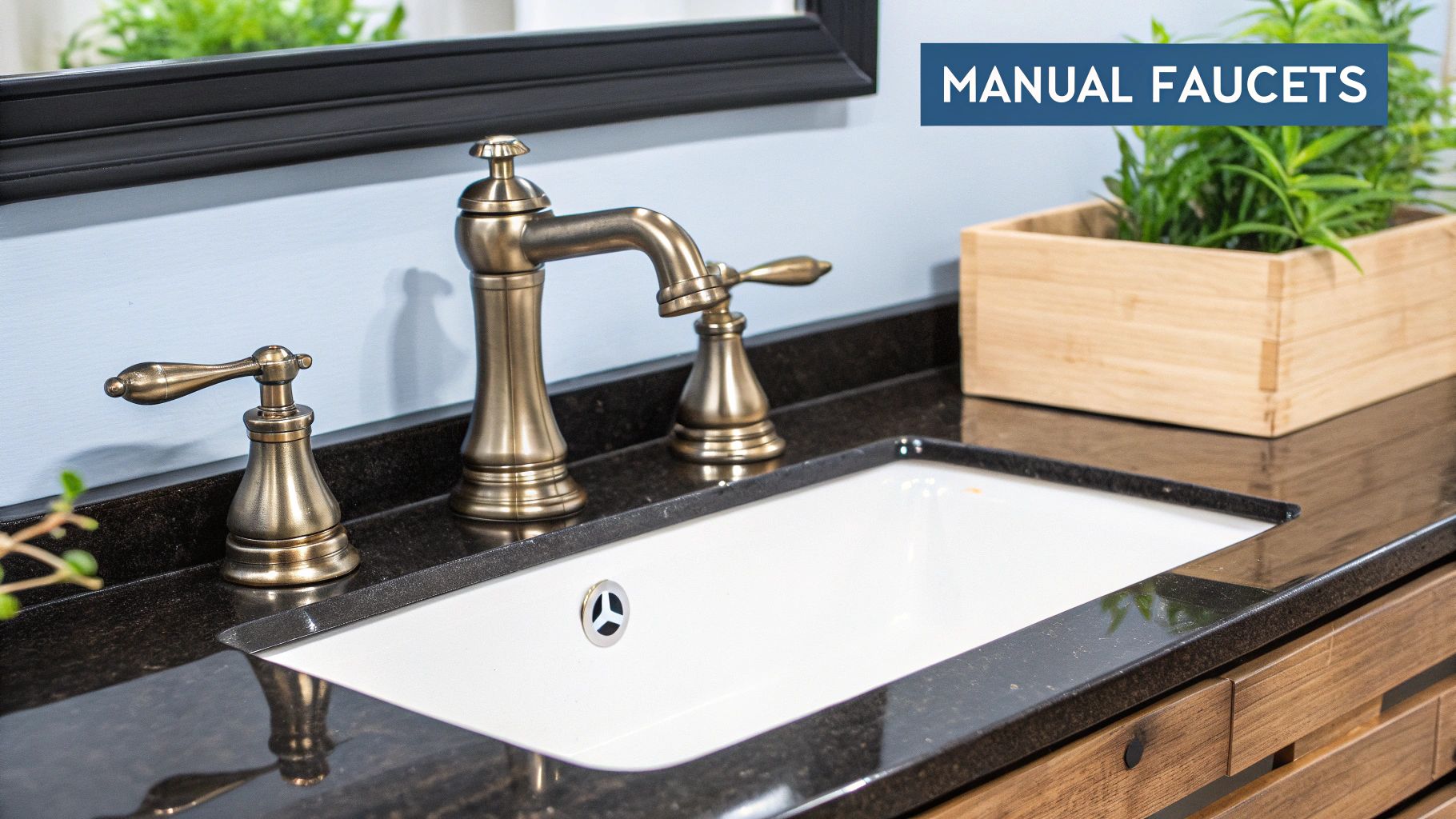
Manual faucets really boil down to two main styles: single-handle and double-handle. Each one offers a totally different feel and look, catering to different tastes in both control and design.
The Simplicity of Single-Handle Faucets
The single-handle faucet is all about clean design and intuitive use. One lever does it all, controlling both water volume and temperature. Just a simple tilt up or down for flow, and a swing left or right for temperature. It’s that easy.
The magic happens inside a component called a cartridge, which does all the water mixing. This simple, effective mechanism is why single-handle designs are a go-to for modern bathrooms where minimalist style and ease of use are top priorities. And if you ever need to do a little DIY maintenance, knowing how to remove a shower cartridge is a great skill to have in your back pocket.
You’ll see these everywhere for a reason. Their affordable price point, straightforward installation, and dead-simple operation have made them a dominant force in the market for years.
The Precision of Double-Handle Faucets
On the other side, you have the classic double-handle faucet, giving you separate controls for hot and cold water. This setup lets you fine-tune the temperature with incredible precision, kind of like having separate bass and treble knobs on an old-school stereo. You can tweak each supply just so until you hit that perfect mix.
While they used to be the standard, you don't see double-handle faucets in new showers as often these days. They’ve found a niche in more traditional or vintage-inspired bathrooms. Their biggest plus is that pinpoint control, but the trade-off is needing two hands to adjust temperature and flow at the same time.
When it comes down to it, picking between these two manual options is a simple choice: Do you want the clean, one-handed convenience of a single-handle faucet, or the detailed, two-handed temperature control of a double-handle setup? Your decision really shapes the day-to-day feel of your shower.
How Advanced Valves Enhance Safety and Comfort
When you move beyond a basic, old-school shower handle, you open up a whole new world of safety and comfort. The real hero behind the different types of shower faucet isn't the shiny fixture you see; it's the valve—the hardworking brain hidden inside your wall. These advanced systems are engineered to do one thing really well: protect you from those shocking, sudden temperature changes.
One of the most common and important upgrades is the pressure-balancing valve. Think of it as a smart bodyguard for your shower. If someone flushes a toilet elsewhere in the house, the cold water pressure drops instantly. This valve senses that change and immediately reduces the hot water flow to match, preventing a dangerous, scalding surge.
This simple bit of engineering is a huge leap in shower safety, especially for families with young children or elderly members. Its main job is to maintain a consistent ratio of hot to cold water, ensuring your shower stays safe and predictable from start to finish.
Thermostatic Valves: The Ultimate Temperature Control
While pressure-balancing valves are all about preventing scalding, thermostatic valves take things a step further by delivering absolute temperature precision. A thermostatic system is like having climate control for your shower. You set your ideal temperature—say, a perfect 104°F—and the valve holds it there, no matter what.
Inside, a small wax element expands or contracts as water temperature changes, automatically adjusting the mix of hot and cold water to maintain your exact setting. This means that even if your home’s water pressure dips or the water heater kicks on, your shower stays precisely where you want it. You can dive deeper into the mechanics by reading about the types of faucet valves and how they work.
This diagram helps visualize the complex engineering going on behind the scenes to keep you comfortable and safe.
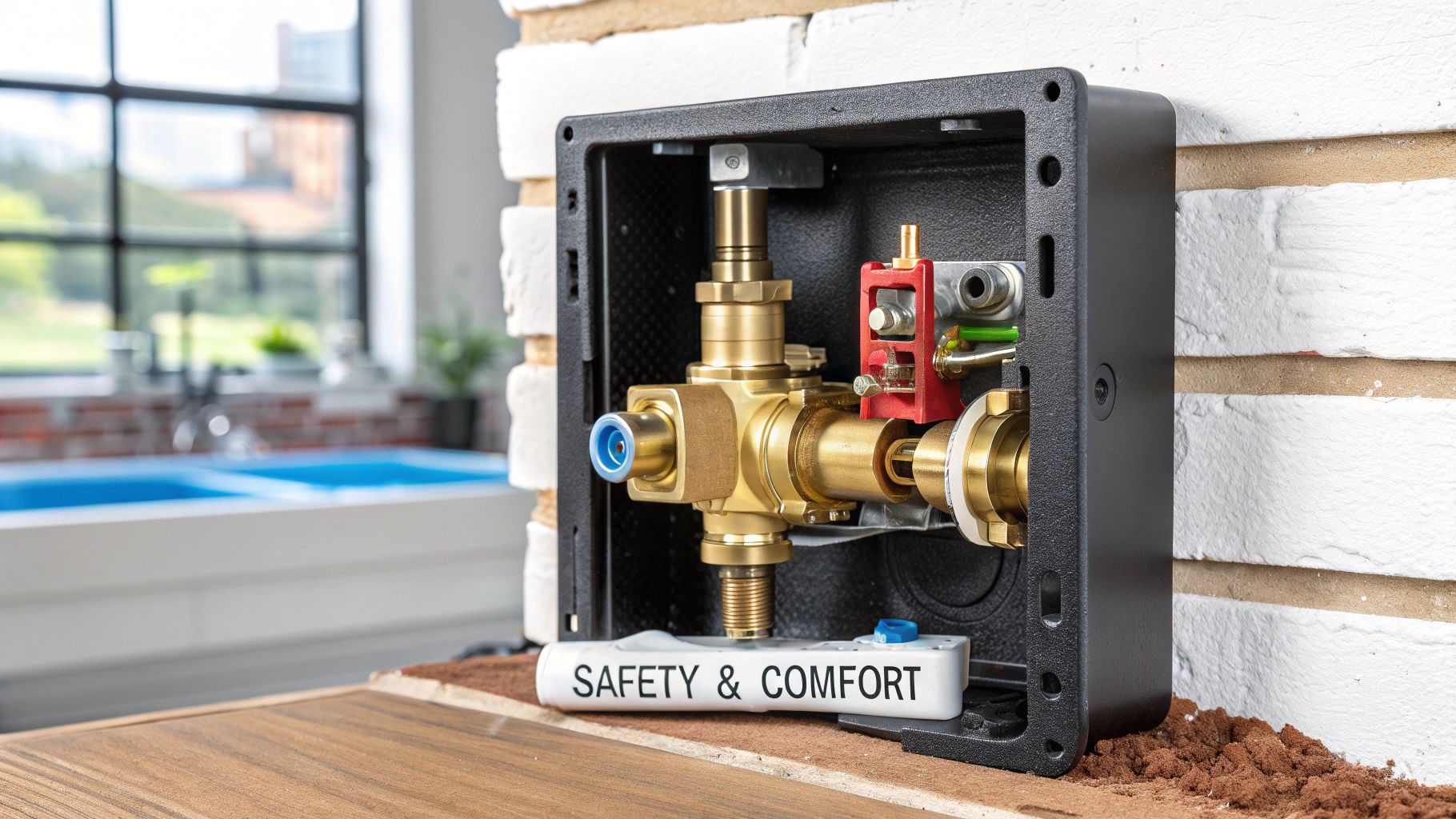
It’s this kind of sophisticated design that turns a simple fixture into a smart safety device, giving you total peace of mind.
Comparing Valve Technologies
So, which one is right for your bathroom? It really comes down to balancing your safety needs with your desire for a truly premium shower experience.
- Pressure-Balancing Valves: These are the industry standard for anti-scald protection. They're reliable, affordable, and often required by building codes in new homes for good reason.
- Thermostatic Valves: This is where you step into luxury. They offer both top-tier anti-scald protection and perfect temperature precision, making them ideal for high-end bathrooms or systems with multiple outlets, like a rain shower faucet paired with body jets.
Both options are a massive improvement over old manual faucets. For anyone looking for that perfect blend of performance and design, CRANACH offers systems that integrate this advanced thermostatic technology, turning your daily shower into a spa-like retreat.
Creating a Spa Experience with Specialty Faucets
Some showers are just about getting clean. Others are about completely transforming your daily routine into a luxurious, spa-like escape. This is where specialty fixtures come in, focusing less on simple function and more on the quality of the water delivery itself. It’s how you turn a bathroom into your own personal sanctuary.
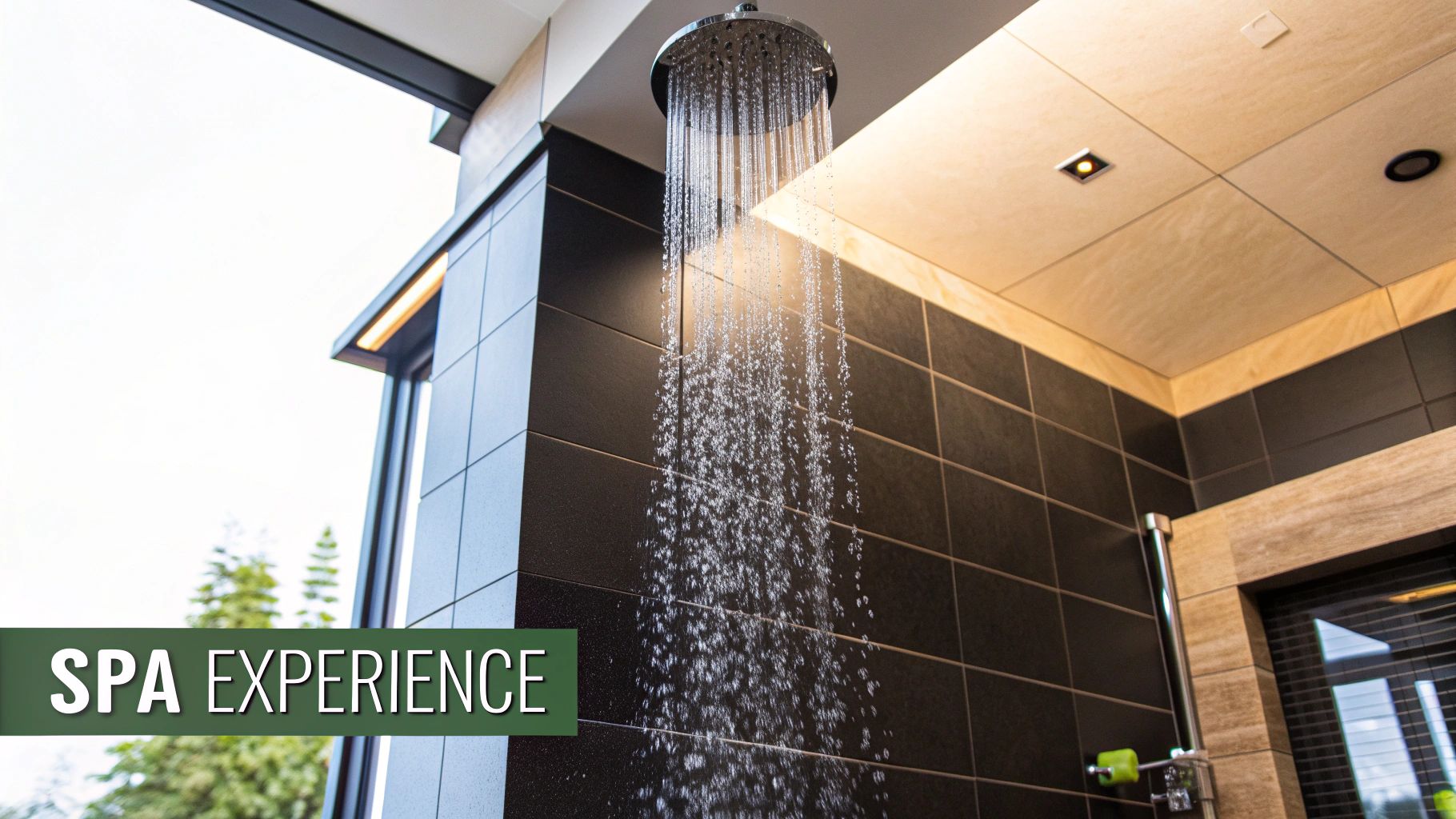
The undeniable star of this category is the rain shower faucet. Using a large, overhead showerhead, it delivers a gentle, all-encompassing flow that feels just like a warm summer downpour. This isn't your standard, high-pressure spray; it's a calming, full-body drench designed for pure relaxation.
The Rise of the Rain Shower Faucet
Getting that perfect rain shower faucet experience just right depends on a few key things. Because the head is mounted directly above you, ceiling height is the first thing to check—you need enough clearance. Your home's water pressure also has to be up to the task of supplying that signature, even flow across a large surface.
The goal of a rain shower isn't just to get clean; it's to create a moment of tranquility. The broad, gentle water flow is designed to reduce stress and provide a more immersive, relaxing shower from start to finish.
If you're looking for more ways to build your personal retreat, our guide filled with spa bathroom ideas is the perfect place to find inspiration for your new fixture.
Versatility with the Bath Shower Set
For bathrooms with a classic tub-and-shower combo, the bath shower set is an elegant and incredibly practical all-in-one solution. This setup usually brings together a tub spout, a showerhead, and a diverter valve that lets you switch between them effortlessly. You get the flexibility for a quick, energizing shower or a long, relaxing soak, all without needing separate plumbing fixtures.
Today’s bath shower set systems often come loaded with advanced features, including pressure-balancing or thermostatic valves that make your shower safer and more comfortable. This makes them a go-to choice for family bathrooms, guest suites, and any space where you need that do-it-all versatility.
Luxury Engineering: The CRANACH Rugen Collection
To see how these concepts come together with top-tier engineering, look no further than the CRANACH rugen collection shower product. This collection truly embodies the spa-at-home philosophy by blending sleek, modern aesthetics with unbeatable performance. Even in homes with average water pressure, the rain shower faucet in this line is engineered to produce that perfect, gentle cascade.
Every single component, from the precision thermostatic valve to the hand-polished finishes, is crafted to elevate the experience. You can explore the full CRANACH Rugen Collection of bath and shower systems to see the craftsmanship firsthand.
Choosing the Right Materials and Finishes
A faucet’s beauty is more than just skin deep. The material and finish are what really determine its durability and how it holds up over time. Making a smart, lasting choice starts with knowing what goes into a high-quality shower faucet. Let’s break down the core materials and stylish finishes that define both form and function.
There's a reason robust materials like solid brass and stainless steel are the industry standard. They offer incredible resistance to corrosion and wear, making sure the internal parts of your shower system can handle daily use for years to come. Think of it as the strong foundation that supports the whole structure.
Popular Finishes for Every Style
The finish is where your personal style really shines. It’s the first thing you see and touch, and it sets the entire aesthetic tone for your shower space.
- Polished Chrome: This one is timeless and versatile. Polished chrome is like the classic black dress of bathroom design—it just always works. Its bright, reflective surface is incredibly easy to match with other fixtures.
- Brushed Nickel: If you want a softer, more contemporary look, brushed nickel is a fantastic option. Its subtle texture cleverly hides fingerprints and water spots, making it a super practical choice for busy households.
- Matte Black: For a bold, modern statement, nothing beats matte black. It provides a dramatic contrast that feels both sophisticated and a little bit edgy, pairing beautifully with minimalist or industrial-inspired designs.
When you're picking materials and finishes, don't forget to think about how easy they are to clean. It’s worth learning how to remove soap scum from shower to keep your new fixtures looking brand new.
Smart Features and Sustainable Design
Beyond looks, the future of bathroom design is being shaped by technology and sustainability. We're seeing a growing demand for shower faucets that can integrate with smart home systems and support eco-friendly living. While manual faucets are still everywhere, smart faucets with digital controls and touchless activation are quickly gaining ground. On top of that, new building codes often require water-efficient fixtures, pushing manufacturers to innovate with sustainable designs.
Choosing the right materials and finishes isn't just about looks—it's an investment in the longevity, functionality, and future-readiness of your bathroom. Premium brands like CRANACH prioritize durable, lead-free brass construction and resilient finishes across all their shower systems.
Ready to Find Your Perfect CRANACH Shower System?
You’ve explored the features and figured out what makes the perfect shower for you. Now, let’s bring that vision home. Finding the right CRANACH fixture is a simple, straightforward process, whether you're a homeowner tackling a remodel or a trade professional sourcing for a client.
For those who need to see and feel the quality up close—and we get it, some things just have to be experienced—our network of authorized dealers is the perfect place to start. You can find a local showroom using the official CRANACH store locator. It's the best way to get a feel for our craftsmanship and see the finishes in person before making your final choice.
A Program Just for Our Professional Partners
We have something special for the designers, architects, builders, and contractors we work with. The CRANACH Pro program is built to support your business with benefits that make your job easier.
- Exclusive Trade Pricing: Get access to special pricing that's only available to our professional partners.
- Dedicated Project Support: You'll have an expert to help with guidance and assistance for your specific projects.
- Wholesale Opportunities: We make procurement seamless for large-scale jobs and ongoing needs.
When you join, you're not just getting a supplier; you're getting a reliable partner dedicated to providing high-quality fixtures that will impress your clients and stand the test of time.
Professionals are invited to explore the Cranach Pro program and request a wholesale price book today. Whether you’re choosing a sophisticated rain shower faucet or a complete bath shower set, CRANACH makes it easy to get exactly what you need. To see all the possibilities, take a look at the extensive collection in our complete shower system catalog.
Common Questions About Shower Faucets
When you start digging into the different types of shower faucets, a few questions pop up almost every time. Getting clear, real-world answers can make all the difference, helping you lock in a final decision with total confidence. You want a system that works for your life, covering safety, performance, and, of course, style.
What Is the Difference Between Thermostatic and Pressure-Balancing?
Think of a thermostatic faucet as setting cruise control for your shower's temperature. You dial it to your perfect 104°F, and it stays right there, period. It doesn't care if someone flushes a toilet or starts the dishwasher; it actively mixes hot and cold water to hold that exact temperature for you.
A pressure-balancing faucet, on the other hand, is more like a referee. It doesn't control the actual temperature, but it does manage the ratio of hot to cold water pressure. If the cold water pressure suddenly tanks (like that toilet flush), it immediately cuts back the hot water flow to match. This smart reflex prevents you from getting scalded.
So, in a nutshell: thermostatic offers absolute temperature precision, while pressure-balancing is a very common and effective safety feature that prevents dangerous temperature spikes. For a deeper dive into the mechanics, the Plumbing-Heating-Cooling Contractors Association has some great technical resources on how these valves work.
Can I Replace My Old Faucet with Any New Type?
Unfortunately, it’s usually not that simple. The beautiful new faucet trim you see on the outside of the shower wall is only one half of the equation. It has to be compatible with the valve that's hidden inside the wall.
If you’re moving from a basic, old-school manual faucet to a modern thermostatic system, you'll almost certainly need to replace that in-wall valve. This is a job that involves opening up the wall and is definitely best left to a professional plumber.
To make life easier for future upgrades, brands like CRANACH have designed universal valve systems. This is a game-changer because it lets you swap out your faucet trim and style years from now without having to tear into your tile work all over again.
What Should I Consider for a Rain Shower Faucet?
Ah, the rain shower. To get that truly luxurious, spa-like downpour, you need to nail three things:
- Ceiling Height: You've got to have enough vertical space for the fixture to hang down and still give you comfortable clearance underneath.
- Water Pressure: That signature, full-drench experience depends on having solid water pressure in your home. Too low, and you’ll get more of a drizzle than a downpour.
- Plumbing: Most homes aren’t pre-plumbed for a ceiling-mounted shower. This means a plumber will likely need to run a new supply line overhead.
But don't worry if a ceiling-mounted head isn't in the cards for your space. CRANACH also makes some beautiful wall-mounted rain shower faucet arms. They extend out from the wall to give you that same immersive feel without the need for major plumbing surgery.
At CRANACH, we’re obsessed with engineering products that deliver an experience, not just a function. Our rugen collection shower product is the perfect blend of stunning design and cutting-edge thermostatic technology, designed to turn your daily shower into a true ritual. Take a look at the CRANACH Rugen Collection and find the perfect bath shower set to elevate your home.

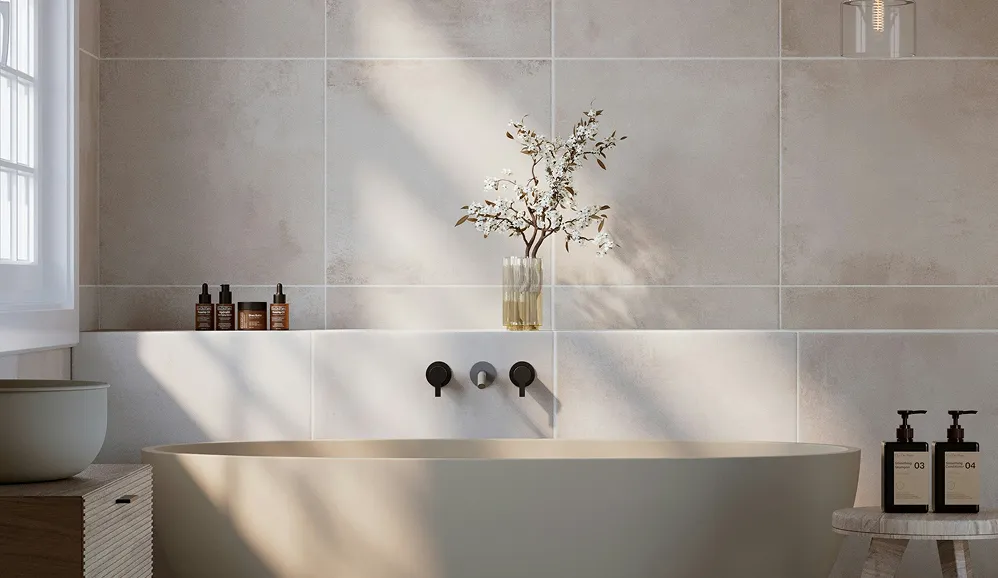
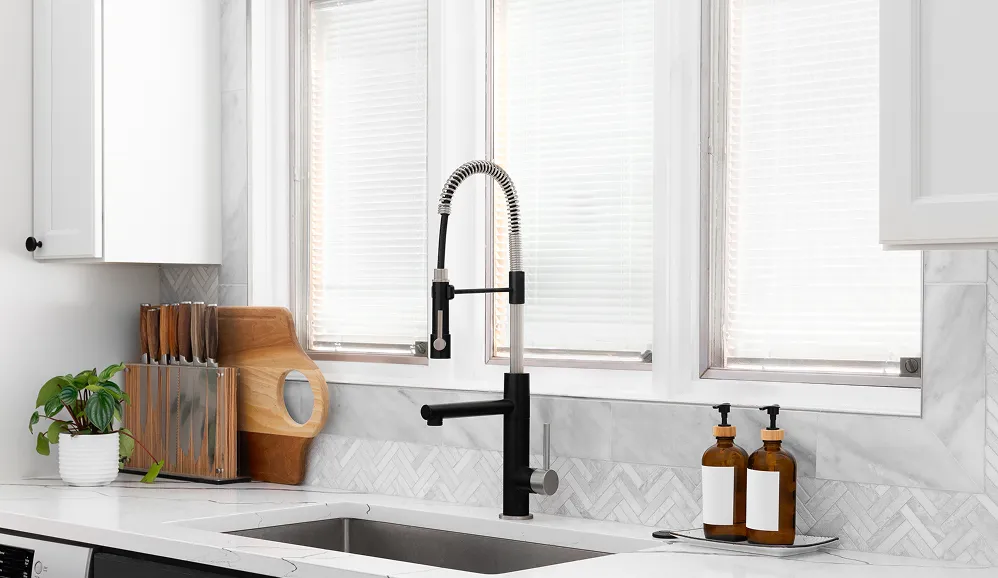
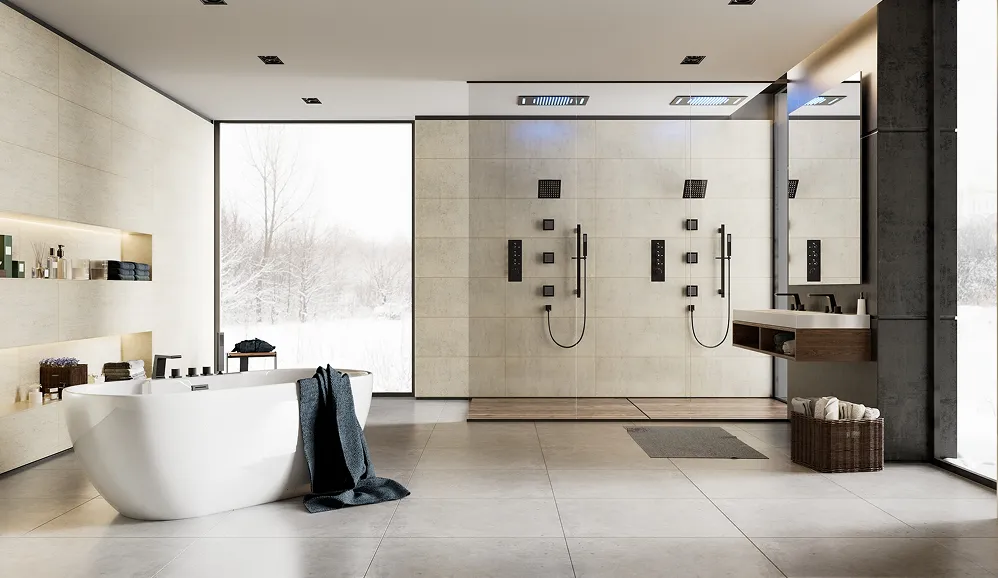
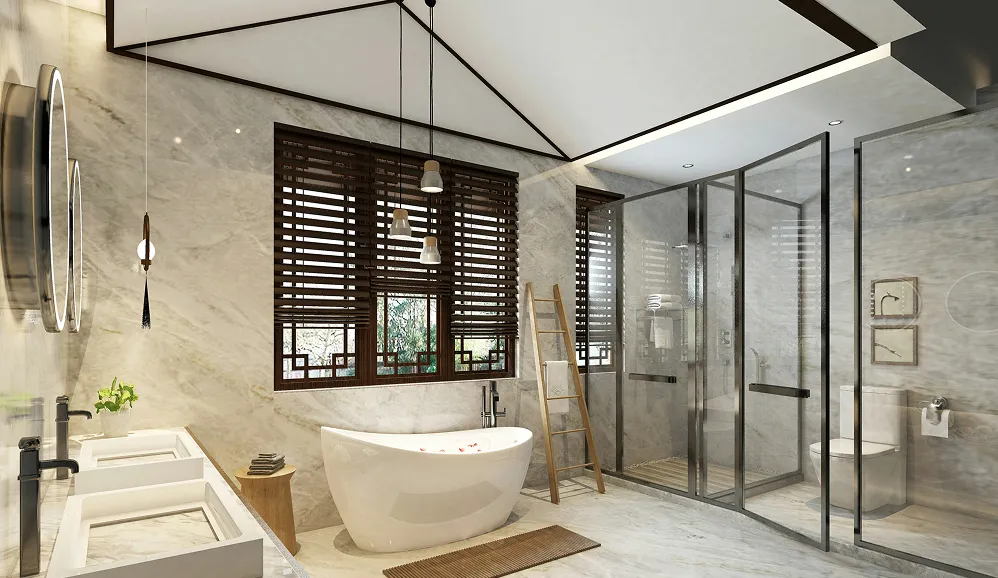

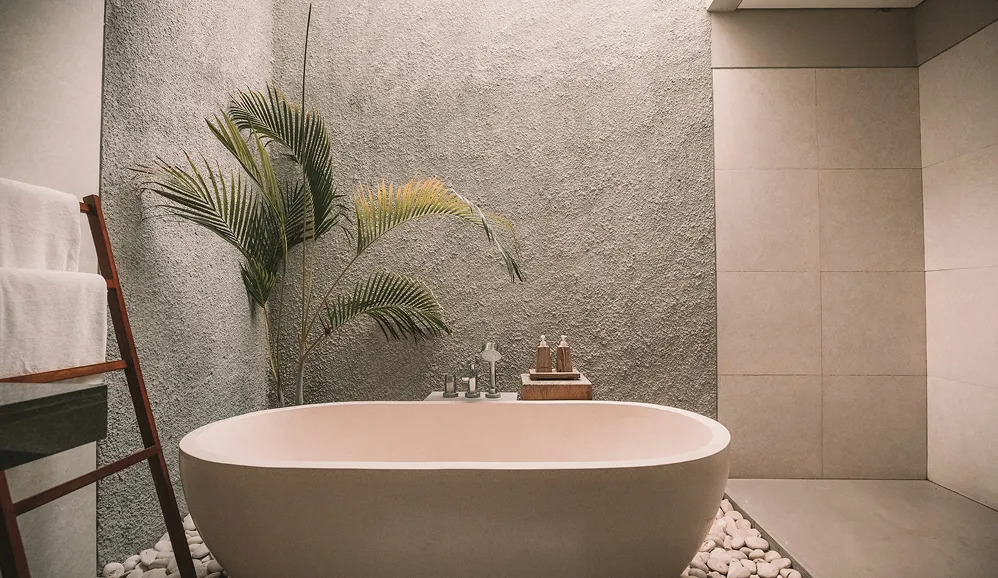
Leave a Reply